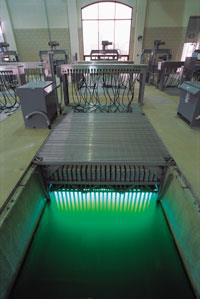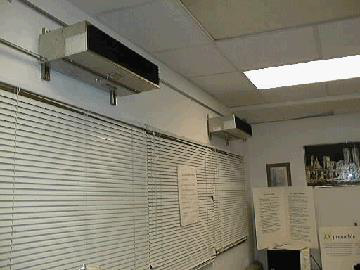7.3 UV-Disinfection and Lamp Control
UV radiation can have harmful effects on human skin and eyes, especially during indoor application of high-energy UV irradiators. There is however a positive aspect to UV’s hazardous effect on living organisms. Ultraviolet treatment of drinking and wastewater is a well-established, economical and efficient method for killing germs, bacteria, mold and fungus. It is increasingly being used in the place of conventional water treatment techniques, which use chlorine and ozone, due to cost and environmental reasons.

Fig. 1: UV treatment of wastewater
Source (valid as of 2002): http://www.mindfully.org/Water/UV-Disinfection-Wastewater.htm
Recently, a field study performed in homeless shelters in New York, Birmingham and New Orleans (TB UV Shelter Study, TUSS) has shown that UV treatment of room air with upper room irradiators leads to a drastic reduction of tuberculosis infection rate.

Fig. 2: Upper room UV irradiators help lower tuberculosis infection rates
Source (valid as of 2002): http://www.news.ucf.edu/FY2001-02/011205.html
The CIE divides ultraviolet optical radiation into three ranges:
- UV-A: 315 nm to 400 nm (skin pigmentation)
- UV-B: 280 nm to 315 nm (vitamin D synthesis, erythema)
- UV-C: 200 nm to 280 nm (germicidal action, absorption maximum of DNA).
Below 230 nm, UV radiation has enough energy to break chemical bonds.
Short–wavelength, high-energy ultraviolet radiation in the UV-C spectral range from 100 nm to 280 nm is used in germicidal/bactericidal sterilization of air and water. UV-C at 253.7 nm is also used in EPROM erasure as well as to clean sensitive surfaces in the semiconductor industry. UV curing is another area where UV-C is used.
UV-C Light Sources
Due to its high and pre-dominantly monochromatic output at 253.7 nm, low pressure mercury is the preferred light source in these applications. Medium and high pressure Hg as well as metal halide and other broadband UV sources are also used, particularly in UV curing.
Light Source Life-time
The useful lifetime of high power UV-C sources is limited. UV-C intensity must be monitored to ensure process control.